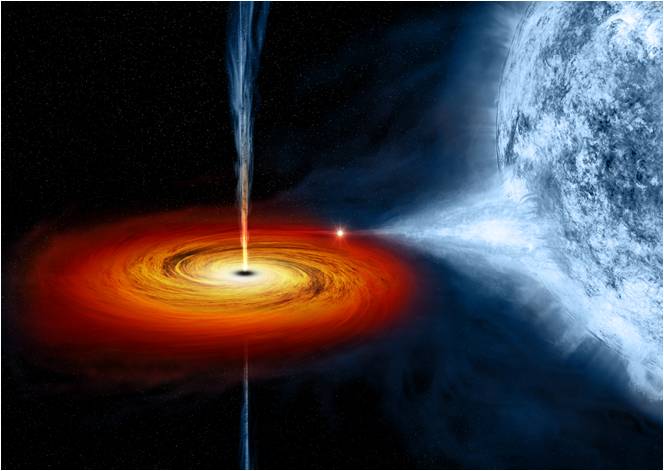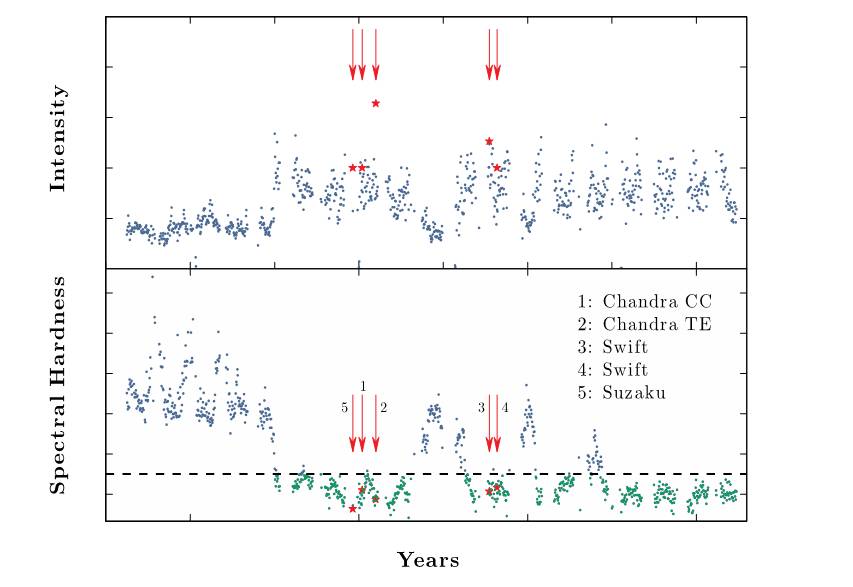The latest research by Lijun Gou, a research professor of NAOC and his main collaborators from Harvard-Smithsonian Center for Astrophysics (CfA) has confirmed the black hole in Cygnus X-1 is an extreme Kerr one, namely, rotating maximally. Theresults are based on the analysis to the multiple X-ray observational data from Chandra, Swift and Suzaku, etc., and the resulting work is already published in the Astrophysical Journal (ApJ; http://iopscience.iop.org/0004-637X/790/1/29/).
Black hole is regarded to have the simplest properties in the Universe, and usually it is readily characterized with three physical parameters (mass, angular momentum, and charge, which is also known as no hair theorem). For an astrophysical black hole, it is even simpler; two will be enough, i.e., mass and angular momentum. Angular momentum is typically parameterized with a dimensionless quantity, i.e., spin parameter, whose absolute value ranges from 0 to 1. 0 is the Schwarzschild black hole (no angular momentum), and 1 represents the extreme Kerr black hole (the maximum).

Fig 1: Artist’s illustration for Cygnus X-1 system. The black hole pulls material from a massive, blue companion star. The material forms a disk (shown in the red color) that rotates together with the black hole before falling into it. Some of the material will be rejected away from the black hole in the form of powerful jets. (Illustration: NASA/CXC/Weiss)
Cygnus X-1 is the first black hole candidate ever discovered, and it exists in a binary system. Since its discovery in 1960s, the debate overits black hole nature had never stopped, especially the black hole bet between two famous physicists,Stephen Hawking and Kip Throne,made this object much more well-known. Theoretically speaking, the criterion of determining whether a compact object is black hole or not is its mass: if its mass is larger than 3-4 solar mass, it will be thought as the black hole candidate. In 2011, Lijun Gou and his collaborators have already made precise measurements (< 10%) to the distance, mass and spin parameter for the black hole in Cygnus X-1. The fits to the optical/IR data show that the mass of the compact object is around 15 solar mass, which confirms that it is a black hole with no doubt. Meanwhile, the X-ray data analysis showed that the black hole is an extreme Kerr one. This is the complete description to the black hole for the first time.

Fig 2: (Top)The light curve monitored by the JapaneseMAXI onboard International Space Station (ISS); (Bottom)the corresponding spectral hardness evolution plot (the smaller the spectral hardness, the more accretion disk component; the observations below the dashed line are suitable for the spin-measurement analysis). The arrows and asterisk symbols indicate the observational epoch performed by each X-ray mission.
It is known that the extreme Kerr black hole plays an important role in many research subjects, e.g., in constraining the evolution of massive stars, in disentangling the jet production mechanism, and also in testing the GR, and so on. Therefore, confirming the spin property of the Cygnus X-1 black hole will provide some observational constraints to those researches. Due to the limits from the observation mode and short exposure time, the spectral quality in the work of 2011 is relatively poorer. Furthermore, only one spectrum satisfiedall the criterionsfor the spin measurement. Therefore, the Kerr nature needs to be confirmed. Out of all those motivations, we proposed observationaltime for several X-ray satellites, and obtained more observational data. In this work, not only more spectra are obtained, and also the spectral quality is better. The analysis to these new X-ray data shows that Cygnus X-1 is indeed a Kerr one, moreover, a tighter constraint to the spin parameter was made: a* is greater than 0.983 at 3sigma (99.7%) level of confidence.
The method used in the spin measurement for the work is commonly named as the X-ray continuum-fitting method, which was initially proposed in 1997 by Shuang-Nan Zhang, currently a joint research professor at IHEP/NAOC. Later it was developed and matured by the researchers at CfA. Nowadays it already becomes the most reliable approach of spin measurement for the stellar-mass black hole.
This work has been sponsored by the CAS Strategic Priority Research Program “The Emergence of Cosmological Structures” and by the National Science Foundation Key Project.

Address: 20A Datun Road, Chaoyang District, Beijing, China code: 100012
Tel: 010-64888708 E-mail: naoc@nao.cas.cn

